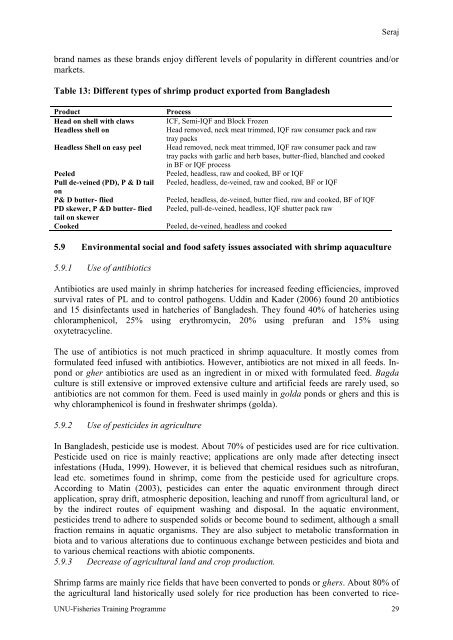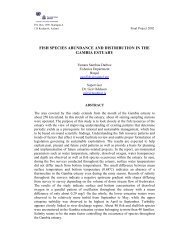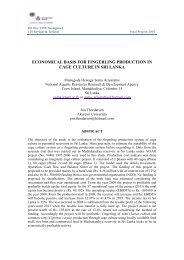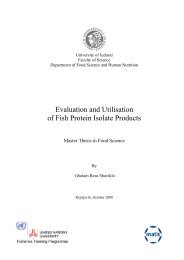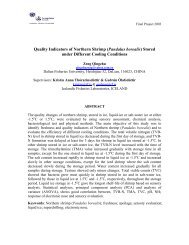a compliance study of Bangladesh shrimp aquaculture - The United ...
a compliance study of Bangladesh shrimp aquaculture - The United ...
a compliance study of Bangladesh shrimp aquaculture - The United ...
Create successful ePaper yourself
Turn your PDF publications into a flip-book with our unique Google optimized e-Paper software.
Serajbrand names as these brands enjoy different levels <strong>of</strong> popularity in different countries and/ormarkets.Table 13: Different types <strong>of</strong> <strong>shrimp</strong> product exported from <strong>Bangladesh</strong>ProductHead on shell with clawsHeadless shell onHeadless Shell on easy peelPeeledPull de-veined (PD), P & D tailonP& D butter- fliedPD skewer, P &D butter- fliedtail on skewerCookedProcessICF, Semi-IQF and Block FrozenHead removed, neck meat trimmed, IQF raw consumer pack and rawtray packsHead removed, neck meat trimmed, IQF raw consumer pack and rawtray packs with garlic and herb bases, butter-flied, blanched and cookedin BF or IQF processPeeled, headless, raw and cooked, BF or IQFPeeled, headless, de-veined, raw and cooked, BF or IQFPeeled, headless, de-veined, butter flied, raw and cooked, BF <strong>of</strong> IQFPeeled, pull-de-veined, headless, IQF shutter pack rawPeeled, de-veined, headless and cooked5.9 Environmental social and food safety issues associated with <strong>shrimp</strong> <strong>aquaculture</strong>5.9.1 Use <strong>of</strong> antibioticsAntibiotics are used mainly in <strong>shrimp</strong> hatcheries for increased feeding efficiencies, improvedsurvival rates <strong>of</strong> PL and to control pathogens. Uddin and Kader (2006) found 20 antibioticsand 15 disinfectants used in hatcheries <strong>of</strong> <strong>Bangladesh</strong>. <strong>The</strong>y found 40% <strong>of</strong> hatcheries usingchloramphenicol, 25% using erythromycin, 20% using prefuran and 15% usingoxytetracycline.<strong>The</strong> use <strong>of</strong> antibiotics is not much practiced in <strong>shrimp</strong> <strong>aquaculture</strong>. It mostly comes fromformulated feed infused with antibiotics. However, antibiotics are not mixed in all feeds. Inpondor gher antibiotics are used as an ingredient in or mixed with formulated feed. Bagdaculture is still extensive or improved extensive culture and artificial feeds are rarely used, soantibiotics are not common for them. Feed is used mainly in golda ponds or ghers and this iswhy chloramphenicol is found in freshwater <strong>shrimp</strong>s (golda).5.9.2 Use <strong>of</strong> pesticides in agricultureIn <strong>Bangladesh</strong>, pesticide use is modest. About 70% <strong>of</strong> pesticides used are for rice cultivation.Pesticide used on rice is mainly reactive; applications are only made after detecting insectinfestations (Huda, 1999). However, it is believed that chemical residues such as nitr<strong>of</strong>uran,lead etc. sometimes found in <strong>shrimp</strong>, come from the pesticide used for agriculture crops.According to Matin (2003), pesticides can enter the aquatic environment through directapplication, spray drift, atmospheric deposition, leaching and run<strong>of</strong>f from agricultural land, orby the indirect routes <strong>of</strong> equipment washing and disposal. In the aquatic environment,pesticides trend to adhere to suspended solids or become bound to sediment, although a smallfraction remains in aquatic organisms. <strong>The</strong>y are also subject to metabolic transformation inbiota and to various alterations due to continuous exchange between pesticides and biota andto various chemical reactions with abiotic components.5.9.3 Decrease <strong>of</strong> agricultural land and crop production.Shrimp farms are mainly rice fields that have been converted to ponds or ghers. About 80% <strong>of</strong>the agricultural land historically used solely for rice production has been converted to rice-UNU-Fisheries Training Programme 29


